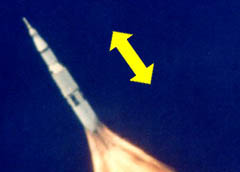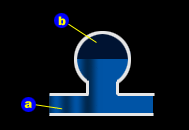pogo and the saturn v







|
Periodic fluctuations in thrust occur in all rocket engines, but normally the mass of the rocket is sufficient to keep it from becoming noticeable or dangerous. But when the thrust fluctuation approaches the resonant frequency of the rocket structure, the forces "couple" and the result is the sense that the rocket is surging backward and forward along its length several times a second. This motion resembles that of a pogo stick, hence the name.[Sutton01, p. 350] The curious feature of pogo is its ability to feed back on itself. The thrust fluctuation caused by unsteady propellant rates in turn causes more unsteadiness in the propellant. Imagine you're in your car, just pulling away from a stop. Now you pull the seat release to allow it to move forward or backward. (Disclaimer: don't actually do this; it's dangerous.) Since the car is accelerating, you slide backward. But this removes your foot from the accelerator, and so the car begins to slow. As it does, you slide forward and your foot re-engages the accelerator, causing you to speed up and the seat to slide backward, and so forth. Engineers eliminate pogo either by adjusting the frequencies at which the structure or propellants vibrate, or by "damping" the vibration in either or both. You can, for example, change the lengths of propellant pipe segments, or put "shock absorbers" in them.
|
|
- Apollo 6 - First use of pogo-damping surge absorbers (Fig. 2) on the first-stage outboard F-1 engines. (The outboard engines have roughly similar propellant line geometries while the center engine's propellant lines are considerably different than the other four.)
- Apollo 10 - Early programmed shutdown of the second-stage center J-2 engine as pogo became apparent in that stage. This was first noticed on Apollo 8.
- Apollo 14 - First use of pogo-damping surge absorber installed on the center J-2 engine. A different pogo problem than the one from Apollo 8 developed in the second stage on Apollos 11 and 12. On Apollo 13 this center J-2 pogo was the cause of the premature shutdown (even before the planned shutdown). Good thing too, because it was later determined that the J-2 thrust structure was vibrating so badly that it would have collapsed had the Saturn V's computer not shut it down when it did. The surge absorber for the J-2 had already been designed and built prior to Apollo 13, but it was too late to install it in the rocket.
It's pretty clear, looking at the history of pogo effects on the Saturn V, that the authors are wrong when they suggest that "everything worked perfectly" after Apollo 10. The authors are trying to create the impression that the Saturn V "suspiciously" worked flawlessly after a number of serious problems in its development. But the facts (most of which the authors don't discuss) suggest a more gradual and progressive improvement.
 The center F-1 engine of
the Saturn V first stage was shut off early in order to fix the pogo
problem. [Ibid.]
The center F-1 engine of
the Saturn V first stage was shut off early in order to fix the pogo
problem. [Ibid.]
The authors' source for this statement is BBC aerospace correspondent Reginald Turnill. As journalists go, Turnill is quite competent. But he is still a secondary source, and it's not clear from Dark Moon whether Turnill or the authors connected the early F-1 shutoff with pogo suppression.
It's true that the center F-1 engine was shut down early, but this was not to solve a pogo problem. It was to reduce the rocket's acceleration just prior to staging. As the Saturn V climbs on its first stage it consumes a large amount of fuel, thereby reducing its mass. The air becomes thinner and offers less resistance to both the escaping exhaust (i.e., thrust increases) and to the rocket itself (i.e., drag decreases). This combination of factors means the Saturn V's acceleration near the end of the first-stage burn would be tremendous if all five of the F-1 engines were allowed to keep firing. Not only would this stress the crew, it would also provide a tremendous jolt when the first stage stopped firing.
This would not have reduced the Saturn V's performance significantly, as the authors fear, because it happened fairly late in the boost, just a few seconds before the first stage was scheduled to stop anyway.
Pogo affected the outboard F-1s, not the inboard engine.
 Other authors say the
second-stage's center engine was cut off early in order to solve the
pogo problem. But the problem was on the first stage, so how
would this have helped?
Other authors say the
second-stage's center engine was cut off early in order to solve the
pogo problem. But the problem was on the first stage, so how
would this have helped?
Had Dark Moon's authors thoroughly researched the pogo issue in the Saturn V they would have discovered that pogo occurred during the operation of both the first and second stages. As it is, they seem to have confused pogo with the F-1 combustion instability problems and therefore they have wrongly concluded that pogo was a first-stage problem only.
The Dark Moon authors attempt to lay blame at NASA's feet for this apparent discrepancy in accounts. However it is clear that the discrepancy derives from the authors' inattention to detail and their confusion of related but different rocketry problems.



